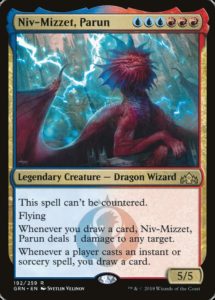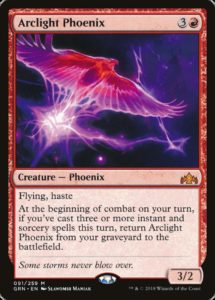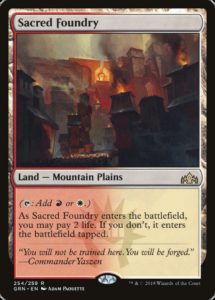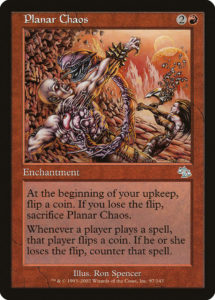Ultimate Masters is out, I had a blast playing it at a PPTQ this past weekend. But we’ve got some unfinished business that UMA will no longer delay: the full set review of Guilds of Ravnica.
Today, we’ll cap off our review with a look at Guilds of Ravnica’s effects on Constructed and a few suggestions that might have helped the Limited format.
Standard
Standard has been through a bit of a ringer in the past couple of years. Guilds of Ravnica’s arrival rotated out Kaladesh block and the mono-red package of Amonkhet. Still, a lot was riding on this new set, particularly player perception of the new Play Design’s team work. And this far, GRN Standard has been nothing short of fantastic.
Sure, it looked like Golgari midrange was the de facto best deck and Standard would yet again be dominated by a Jund-style goodstuff deck with a slightly positive matchup against everything—and then it was beaten back. Sure, Boros dominated the Pro Tour and it looked like a return to another format dominated by aggressive decks—and then control turned around and beat it. There are plenty of viable decks with all sorts of play styles and speeds. You can play a combo/aggro deck with Arclight Phoenix, a hyperaggro deck with Runaway Steam-Kin, a control deck with Teferi, Hero of Dominaria or Niv-Mizzet, Parun. You can play token aggro in monowhite, Boros, or Selesnya. You can even drop down a tier and play actual Storm with Thousand-Year Storm. This Standard format has proven fun to watch, and, dare I say it, fun to play.
I’ve never been a Standard player. Limited is my true passion, and Modern is my favorite way to sling sixty-card decks. I’ve always paid attention to Standard and watched it, but it was never particularly big in my play groups or at my local game stores (and it still isn’t). Buying into Standard just played on all my anxieties—with Modern, I could stop playing for a few months and pick it up again, just fine. Every week I don’t play Standard, that’s a fraction of my deck’s life gone. Every three months, things change and every twelve months, everything changes. Magic Arena was a sea change, as it made buying into Standard facile, essentially free what with all the drafting I do. So, I can confidently say this Standard is fun to play, because for the first time ever, I’m actually playing it.
Standard Rating: A
Modern
Guilds of Ravnica has had an enormous impact on Modern. It accomplished this without obviously broken individual cards like Treasure Cruise or Eldrazi Temple. Instead, it provided an array of powerful tools to a variety of decks. Arclight Phoenix opens up new space for prowess-style decks, Hollow One, and even Burn. Assassin’s Trophy is a powerful tool for Jund and Rock decks to fight back against Planeswalkers and Tron. Risk Factor, Runaway Steam-Kin, and Experimental Frenzy are all cool new tools for red decks. Knight of Autumn is a potent new take on Reclamation Sage, giving Chord of Calling (or in Legacy, Green Sun’s Zenith) decks an excellent, maindeckable silver bullet. And reprinting the shocklands, which have far fewer tournament issues than fetchlands, is always welcome.
Wizards has gotten quite good at having each set or block have maybe one or two cards that see some Modern play, or maybe enable a new archetype or reinvigorate an old one. Guilds of Ravnica has changed the face of Modern without breaking it and spawning only a single new deck, and that’s wonderful. I won’t talk about GRN’s effects on Legacy, Vintage, Commander, or Pauper (as there are far more knowledgeable Hipsters than I as regards those formats), but I am delighted at what GRN has done for Modern.
Modern: A
The Final Score
So, in part 1, we reviewed the mechanics of Guilds of Ravnica. Here are their grades:
Mentor: A-
Surveil: A+
Convoke: D
Jump-start: A-
Undergrowth: C-
In part 2, we reviewed the Limited format.
Balance: C+
Power: B+
Archetypes/Synergy: B+
Replayability: C
Fixing: A
Interaction: A-
Finally, today we went over Constructed.
Standard: A
Modern: A
Overall, Guilds of Ravnica has scored quite well. It has fantastic mechanics, contributed to one of the best Standard formats in recent memory, and has had multiple meaningful but fair impacts on Modern. The Limited format has a lot of fun stuff to it; and if it weren’t for the fragility of both green guilds and the Gates shenanigans deck (and absence of other shenanigans decks), I think Guilds of Ravnica could be one of the all-time great Limited formats, too. However, a poor Replayability score (which tends to be linked to a poor Balance score), really restricted how long I enjoyed the set. Frankly, I was surprised I had so many goods thing to say about GRN Limited when writing this three part series but it goes to show that understanding why something is unsatisfying can lead you to recognize all of the good work put into the set and that the issues are fairly small in size (but with an outsize effect on one’s enjoyment).
In an alternate universe…
For the final part of this series, I’d like to imagine what could be different. What changes would I playtest if I had the ability to redesign some of the set? I’ll focus primarily on cards for Selesnya and Golgari, since I think those guilds have the biggest issues, and we’ll start small and work our way up to the crazy.
Ledev Guardian: what if it cost 2W instead? A three mana 2/4 is by no means unheard of (Colossodon Yearling isn’t a vanilla all-star). A potential two mana 2/4 wouldn’t take over the game, but it could enable Selesnya to play a much more aggressive game, survive better against Boros, and jump up the curve just a bit faster.
Sworn Companions: what if it had Convoke? It’s still nowhere as impressive as Scatter the Seeds, but it rewards players for playing one-drops with an early Convoke spell and can help explode up the curve (though it still won’t enable a turn three Siege Wurm). Perhaps this would lead to Selesnya being able to jump up the curve too fast, but as is, Selesnya seems a bit slow and one-note.
Why is Emmara, Soul of the Accord the only card to reward you for convoking? Why not make a common card like Spireside Infiltrator that gains you two life when it becomes tapped, or a reverse Venerated Loxodon that gets a +1/+1 counter whenever it convokes something? The elephant is the only new usage of Convoke in the set and it’s disappointing that more wasn’t done. Selesnya really needs another a play pattern beyond just playing creatures, perhaps a Convoke-matters or tapped-matters deck could’ve filled the voice.
Glowspore Shaman: what if it were common (and possibly reduced to a 2/1 to compensate)? This runs the risk of giving Golgari overly powerful starts, but the lack of self-mill (absent Surveil, which is generally on excellent cards everyone wants or marginal cards) makes Golgari so slow and so vulnerable to cards like Dimir Informat which can block most creatures without killing them. Golgari doesn’t have as many problems as Selesnya does, but having to rely on your opponent playing along by trading creatures in combat makes Golgari far too inconsistent, especially considering how many good blockers there are.
Undercity Uprising: We’ve already got modal spells in every color, so what if this were modal, too? What if this gave one creature you control deathtouch and allowed another to fight, and cost just BG? It still looks a bit silly being in a set that also has Prey Upon, but I’d argue Undercity Uprising already looks weird alongside Prey Upon and it’s a common spell which grants global Deathtouch (in a set with multiple common tramplers, to boot).
Now, let’s get a bit crazy. There are two cards which resemble build-around uncommon enchantments—however, they’re mythic. I’d have loved to have seen weaker versions at uncommon. These cards are Thousand-Year Storm and Divine Visitation. What if Thousand-Year Storm just copied the second instant or sorcery you played each turn (and still probably cost six mana or so, maybe five)? What if Divine Visitation gave you an extra 1/1 Lifelink or 2/2 Vigilance whenever you created tokens? The flavor would also make more sense, it’s clearly meant to go in Selesnya decks even though it’s a Boros cards (only Boros and Ozhov have angels on Ravnica). I don’t meant to imply that Thousand-Year Storm and Divine Visitation aren’t appropriate mythics. l really like that GRN has several cool mythics like Mnemonic Betrayal, Chance for Glory, and Lazav, the Multifarious that aren’t all pushed for Constructed and have funky, mythic effects (yes, Lazav deserves to be mythic, though so does Niv-Mizzet, Parun). However, I believe that GRN would have benefitted from another build-around uncommon enchantment (particularly since Guild Summit is so lackluster) that encourages wildly different card evaluations. I believe that sets are just better when they have such cards, be they as powerful as Burning Vengeace or clunky as Goblinslide.
And there you, go, all of GRN reviewed. And, as always, thank you for reading.
—Zachary Barash
Zachary Barash is a New York City-based game designer and the commissioner of Team Draft League. He designs for Kingdom Death: Monster, has a Game Design MFA from the NYU Game Center, and does freelance game design. When the stars align, he streams Magic.
His favorite card of the month is Armillary Sphere. Sometimes when you staple two cards together, it costs more—like Shock and Lightning Blast. Less frequently, it costs less—like Cruel Ultimatum compared to Diabolic Edict, Lava Axe, Fugue, Raise Dead, Concentrate, and Chaplain’s Blessing. Armillary Sphere is a card that costs exactly what two Wanderer’s Twigs cost, joining the Mind Stone/Hedron Archive/Dreamstone Hedron family of additive cards producing card advantage.





